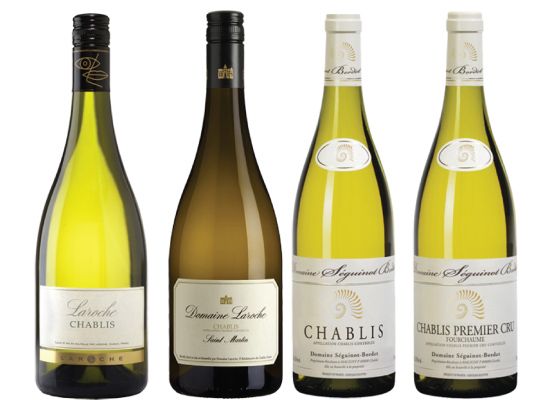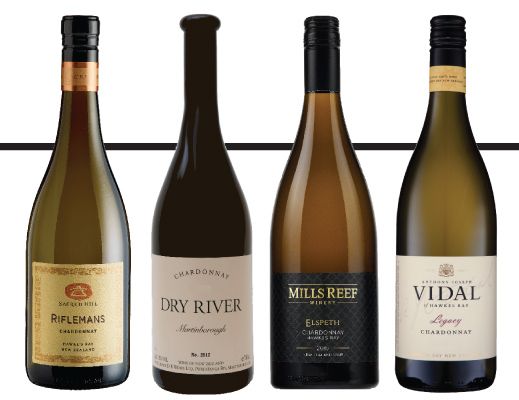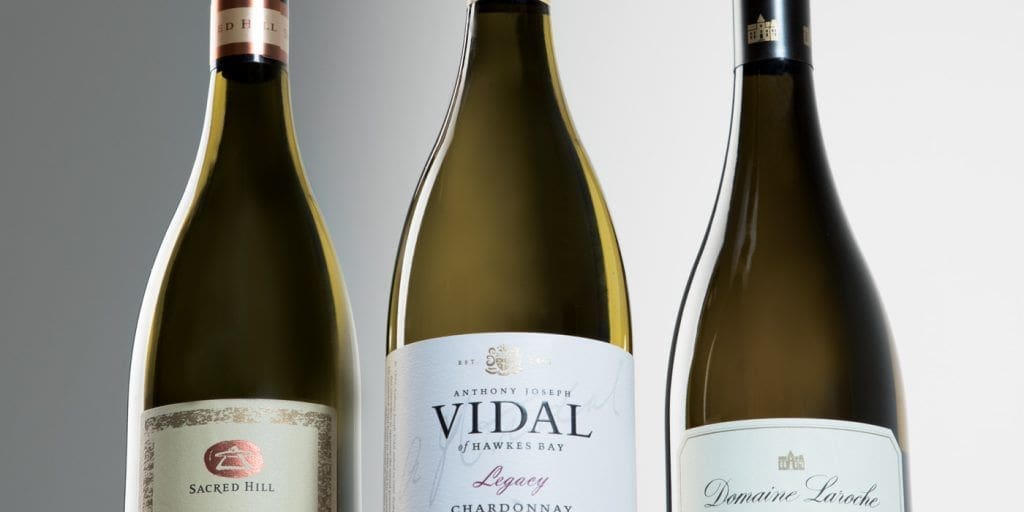Chardonnay VS. Chablis
In this issue we compare some of our best New Zealand Chardonnays with their close relatives from the Chablis region of France. The big difference we found was the flinty minerality of the Chablis versus the more dominant fruit flavours that came through in their New Zealand counterparts.
To be called a Chablis they must use Chardonnay grapes and they must be produced in the Chablis region. The terroir these grapes grow in is very chalky soil, a unique mix of limestone, clay and shell, part of an ancient oyster bed dating back the Jurassic period that spread from the White Cliffs of Dover right down through the northern regions of France – the minerality coming from these chalky soils. The best of our Chardonnays, on the other hand, are grown in arid river beds, combined with differences in the climate (among other variables) to deliver a much different experience. Here are the selection of wines we tried, all between $30 and $70 and all highly rated by our team…
The Chablis

What is unique about the French wines is the history. While our ‘new world’ wines (with the exception of just a few wineries) date back only a few decades, some of these ‘old world’ wineries date back well over 100 years and in some cases 100s of years. These outstanding Chablis were all sourced from Glengarry wines.
Domaine Laroche Chablis 2015 – Chablis, France
The Laroche family have a long history of wine production in the Chablis region going back five generations. As far back as 1850 they have been producing top quality wines like no other. The steely, floral bouquet, delicately crisp, refined flavours and unmistakable underlying flintiness are indelibly characteristics of their terroir.
There was no oak used in the production of this crisp, delicate wine so the flavour is derived purely from the Chardonnay grapes.The wine is bright and lively, replete with flinty notes and minerality infused with notes of citrus and chalk.
Domaine Laroche Chablis St Martin 2015 – Chablis, France
Under the leadership of Michel Laroche the winery has expanded over the years, from just six hectares in 1960 to 130 hectares of prime Chablis land today. With 186 years of winemaking in the family, the Laroche families passion for producing outstanding wine continues – Michel Laroche summing it up succinctly: ‘To produce the best Chablis, you need to produce the best grapes.’
This wine is refined and complex, with a distinctive chalky minerality, typical of the region,enhancing the white fruit & floral characters, zesty acidity and long, fruity finish.
Domaine Séguinot-Bordet Chablis 2016 – Chablis, France
There have been 13 generations of the Séguinot-Bordet family producing wine in Chablis, with a history of winemaking in the region dating back as far as 1590.
Jean-François Bordet has taken his family house to another level, installing a brand new winery in Maligny thus forging a wonderful union between the old and the new.
This is a superb Chablis, with the fruit taken from 25-year-old vines. It delivers a rich and elegant wine with notes of honeyed flowers and spice, creamy textures and a fresh mineral finish.
Domaine Séguinot-Bordet Premier Cru Fourchaume Chablis 2016 – Chablis, France
This is their signature Chablis and comes off the Premier Cru vineyard Fourchaume, which they part own.
Harvesting their crops later with reduced cropping levels, it is fermented and matured strictly in stainless steel and it achieves fresh, clean fruit underscored by the minerality that characterises the classic Chablis style.
This wine has distinctive liquorice and fennel notes. Crisp and dry with elegant minerality and fine citrus notes. A truly outstanding wine with all the idiosyncrasies of a Chablis premier cru.
The Chardonnays

Sacred Hill ‘The Rifleman’ Chardonnay 2016 – Hawkes Bay
Sacred Hill derives its name from Puketapu (Sacred Hill in Maori) where the winery was first established back in the 1980’s. Today Sacred Hill is one of the few large wineries in Hawkes Bay still under the original family ownership. Renowned for their award winning Chardonnays produced from grapes grown in one of the best Chardonnay growing regions in the country, the Rifleman in the icon of their Chardonnay range.
The name Rifleman was inspired by our smallest native bird of the same name. But this iconic wine is no small wine! The 2016 Rifleman is another very classical Chardonnay with an intense palate and sensational length receiving prestigious awards over multiple vintages.
The Rifleman Chardonnay 2016 is another powerful, elegant vintage with intriguing, lifted aromas of ripe mandarin peel, nectarine, hazelnut and vanilla bean with nuances of nutmeg and lemon meringue. As the experts agree, patient cellaring will be very well rewarded.
Dry River Chardonnay 2016 – Martinborough
The name Dry River is the name of one of the original sheep stations situated in this region of Martinborough in the late 1800’s. The name was almost lost to history when it was renamed Dyerville in 1900 while the river became known by its Maori name the Waihora river. The Dry River name was reclaimed in 1979 as the name of the vineyard located just a few kilometers from Dyerville on a very arid, gravely and free-draining site now called the ‘Martinborough Terrace. ‘ Aptly named Dry River due to the dry conditions – they use no irrigation, and coupled with the older vines this means low yields and outstanding wines from this site – of which their Chardonnay is no acception.
The colour is golden straw and the nose is soft and creamy, layered with golden kiwifruit, pineapple and almond nougat, opulent and energetic with characters of brioche and crème caramel and hints of freshly crushed thyme and lemon rind. The palate is almond croissant, Beurre Bosc pears and barely noticeable toast, a lemon sorbet character allows for a long finish.
Mills Reef Elspeth Chardonnay 2015 – Hawkes Bay
If you have followed my column over the past year then Mills Reef needs little introduction. With origins back in the ‘80s as a kiwifruit wine producer based in Tauranga and exporting to Japan, this winery has emerged as one of the best boutique wineries in New Zealand. Producing outstanding Bordeaux style reds and Chardonnays from the Hawkes Bay region, this little winery has taken out a huge number of awards and regular praise for some of our leading wine writers.
The Elspeth range represents their top tier of wines produced exclusively from grapes grown in the Gimblett Gravels region, from hand-picked fruit of exceptional quality. The name Elspeth was winemaker (and son of Mills Reef’s founder), Tim Preston’s grandmother’s name.
A small percentage of this wine went through malolactic fermentation, while 100% went through French oak ageing, to deliver a judicious seasoning of toasty oak and a lovely rich creamy texture. This outstanding Chardonnay has striking intensity, complexity and balance. Tropical peach, fig and honey flavours abound, intertwined with hints of cashew, Already delicious, it will continue to evolve and delight with cellaring.
Vidal legacy Chardonnay 2016 – Hawkes Bay
The Legacy range is the top tier of the Vidal selection and a nod to the legacy of Joseph Anthony Vidal who founded the Vidal vineyards in Hawkes Bay in 1888. To compare the growing area designated to this Chardonnay, one could comfortably use the Burgundian analogy of ‘grand cru’, since the grapes come from some of the best growing area in the country.
One of the top Chardonnays in the country, the Vidal Legacy 2016, displays a flinty minerality that sets it apart from most of the other New Zealand Chardonnays and the closest in this selection to the traditional Chablis, encapsulating concentration, freshness and restraint.
The colour is a lovely golden hue with fragrant flinty aromatics of citrus, pink grapefruit and roasted nuts on a finely styled, textured and seamless palate. Showing harmony and complexity. Distinctive and age-worthy and deserving of the title ‘legacy’.

